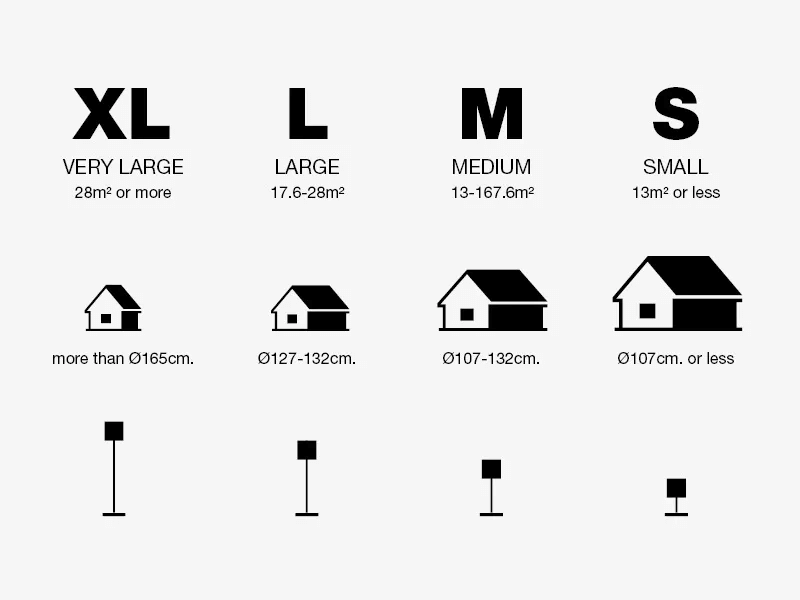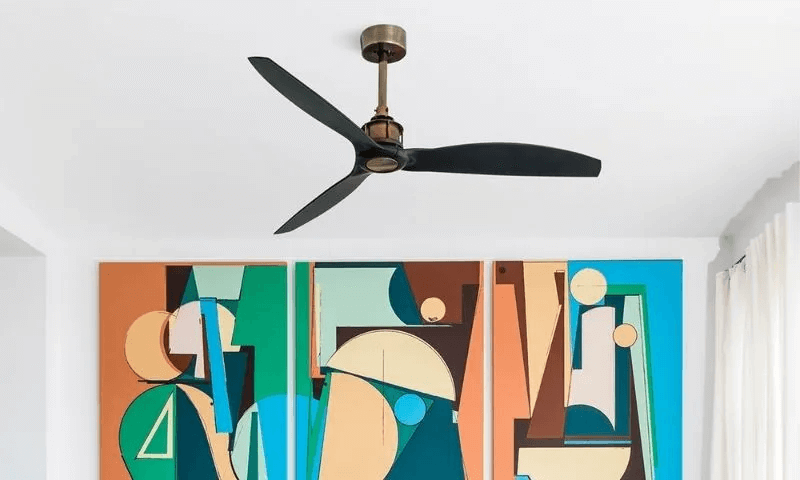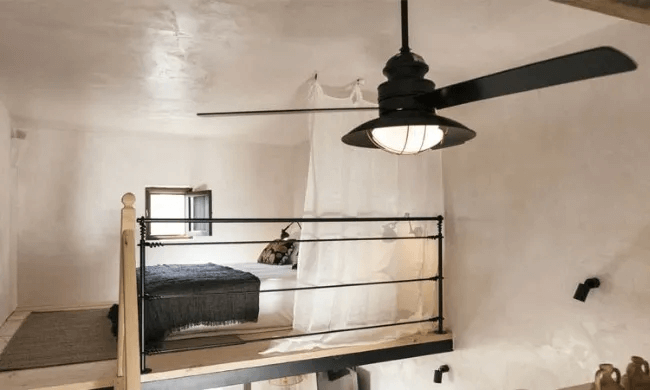Ceiling fans are a great way to cool the air in a healthy way. In addition, they add a decorative touch to the room and even provide light. But choosing a ceiling fan is not always easy.
Issues such as the height of the ceiling, the size of the room or the slope of the ceiling can influence the choice of fan. Therefore, we leave you with a guide with the best tips on how to choose the ideal ceiling fan for the room you are looking for.
Which type of fan to choose depending on the room?
When considering how to choose a ceiling fan, it is most important to consider the area to be ventilated, the square footage of the area, the ceiling height, the location and the ambience of the room.
Which fan size to choose
Indoor fans can be used in all rooms of the house and therefore we have to take into account the size of the space where we want to install it.
For extra-large rooms (more than 28 m2): The diameter must be equal to or greater than 165cm.
For large rooms (between 17,6 - 28m2): The diameter has to be equal to or larger than 132cm.
For medium sized rooms (between 13 -17,6m2): The diameter should be between 107-132 cm.
For smaller rooms (less than 13 m2): The diameter has to be 107cm or less.
Although the tendency is always to choose small fans for fear that they will stand out too much, it is always advisable to choose slightly larger models, as longer blades mean that, with a much slower movement and more air moved.

A small ceiling fan, on the other hand, needs a higher speed to produce the same breeze, and it is precisely this speed that will make it stand out rather than go unnoticed. However, this will depend on the size of the space in which it is placed.
Fan with or without light
Some ceiling fans also have the option of including a light.
Ceiling fans with light: quite useful in areas such as bedrooms.
Ceiling fans without light: for rooms such as the living or dining room. Here it is better to use a healthy ventilation system such as the ceiling fan and to make better use of more adequate lighting.
Outdoor ceiling fan
For outdoor spaces such as terraces, entrances or porches, it is very important that the fan is IP44 rated so that it is prepared for environmental adversities such as humidity, dust, weathering or splashing.

Blade size and direction
Although many people tend to think that the more blades, the cooler, this is not true. The number of blades on a ceiling fan does not have much influence on its performance, but is more a question of aesthetics.
The air movement generated by the fan has more to do with factors such as the inclination of the blades or the length of the blades, and in terms of the number of blades, the opposite is true: the fewer the blades, the more air will be moved.
The two-bladed ones are ideal for large spaces.
Fans with more blades, e.g. five, serve to cool rooms slightly.
Design, finishes and colour
Another of the most important questions when considering how to choose a ceiling fan is the design, finish or colour.
Industrial style ceiling fans
Minimalist ceiling fans
Vintage style ceiling fans
Nordic style ceiling fans
Tropical style ceiling fans
In any case, the fan must fit in and integrate into the space like any other decorative element, so these characteristics must be, in some way, in line with the general style of the room in which it is placed.
In addition, it should be borne in mind that some materials need more care than others, although they are all designed for minimum maintenance.
Wooden paddles are ideal for living rooms or bedrooms.
Polycarbonate or metal fans are best for kitchens or bathrooms.
Pitched roof fan
If you want to install the fan on a sloping roof, such as a dormer or a porch, you must take into account that:
The maximum angle at which you can install your fan is 20°.
The rosette of the chosen model must be suitable for pitched roofs.
In any case, installation is the same as when the ceiling is not sloped, just adjust as needed. Make sure that the fan is far enough away from the ceiling so that the blades do not touch it.
Which motor (AC/DC) is most suitable for the ceiling fan?
Ceiling fan motors can be of two types:
DC: Direct current or direct current. They are more efficient, consume 70% less energy and offer 5 to 6 adjustable speeds. In addition, they have better performance and are much quieter and more durable, as they have a motor that uses all the energy it consumes and works better as it does not heat up as much.
AC: Alternating current. Their price is a little lower, but they are less efficient and quieter. They offer only 3 speeds.
Ceiling fan summer and winter mode

Ceiling fans are an effective way to reduce energy costs all year round and create a pleasant atmosphere, thanks to the reverse function, which is available on fans with DC motors.
In summer. The blades rotate counterclockwise for natural coolness or in combination with air conditioning, resulting in energy savings of up to 40%.
In winter. The fan blades rotate clockwise to better distribute the layers of warm air, eliminate stratification and save up to 10% of electricity.
Consumption of the ceiling fan
The power consumption of a fan depends on three main factors:
The speed of operation. Most fans have at least three speeds, but some models have more, such as DC fans which have six.
Whether it has a light or not. Fans with light are a good option because they solve two problems at the same time. In this case their consumption will be higher.
Motor type. DC motors consume up to 70% less than AC motors.
Recommended fan rotation speed
Each space requires an appropriate range of fan rotation speeds.
For the bedroom or office a low speed of 50-100 rpm is best, which cools, but does not disturb.
For large spaces such as a dining room or a business with a living room, a maximum rotation speed of 200-300 rpm is best, which, apart from cooling, will disperse fumes and odours.

How to install the ceiling fan
Install on a normal roof
For proper operation of your fan and proper air circulation, we recommend:
Between the wall and the shovel, at least one metre.
From the ground to the blades, there should be a minimum height of 2.3m. However, in transit areas, they should not hang below 2.20m.
This is the minimum distance to ensure optimum air movement. If the room is smaller, we recommend fans that can be installed directly to the ceiling.
They could be placed lower if placed in areas such as above a dining table or bed, where the risk of collision with the fan is minimal. It is also essential that the ceiling where it is installed is strong.
Installing a ceiling fan on a high or pitched roof
As ventilation experts, we recommend placing the fan at a height of 2.8 metres if a high ceiling is involved. At the same time, there should be at least one metre between the fan and the next object (e.g. a piece of furniture). To do this, use the extensions on the stems.
In the case of a sloping roof, look for fans that are suitable for this and respect the maximum angle of 20°.
Who should install the ceiling fan: private individual or specialist
If the instructions detailed in our manuals are followed, the installation of the fan should not be a difficult task. However, like any other device that requires electrical installation, it is recommended that the installation be carried out by a specialist.
Maintenance of the ceiling fan
The ceiling fan does not require too much technical maintenance. Just keep in mind that the use of water for cleaning is not recommended, as it can damage the motor. The fan should not be lubricated either. The motor has permanently lubricated bearings. Our recommendation is to use a soft cloth to avoid scratching the finish.
If the roof-mounted fan is inactive for a long period of time, disconnect the power supply to avoid an electrical overload of the components.
After a long period without switching on the fan, it is advisable to check the connections, the screws, the fixing of the support to the ceiling and that all the blades and their supports have the same or similar inclination.

Benefits of the ceiling fan
Ceiling fans are a healthy form of ventilation that is not only limited to homes, but is also quite useful in spaces such as offices, restaurants and even the retail sector.
They provide a pleasant cooling sensation of up to 8° lower than the actual temperature.
They are healthier than air conditioning
They consume up to 47%, in contrast to other cooling devices.
They add a decorative touch to the space in which they are placed.
The fact is that the use of ceiling fans does not lead to a real drop in temperature, but they do increase the sensation of greater coolness.
Improve the ambience of each space
In the kitchen. A space with more than one window and an extractor fan will help to remove bad smells or smoke.
In the dining room. It is one of the most furnished spaces in the house. When choosing the fan, it is good to consider what material it is made of and what colour it is to create a unique atmosphere.
Bedroom. Quiet fans with DC motors are ideal fans for the bedroom because of their low power consumption, the low noise they emit and the soft breezy air they provide. Don't let the high temperatures spoil your nights!
Other questions about the ceiling fan
How much air do the fans move?
The amount of air moved by fans is measured in cubic metres per minute. The greater the amount of air moved by the fan, the greater the sensation of cold or heat, depending on the function selected.
What does RPM indicate?
The RPM-revolutions per minute-indicates the speed at which the fan rotates and is therefore related to its consumption. The higher the RPM, the higher the consumption.


































